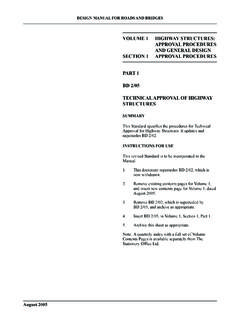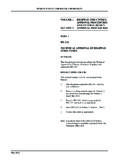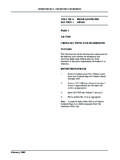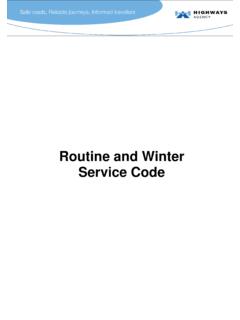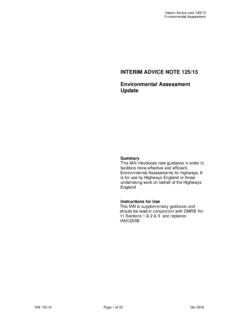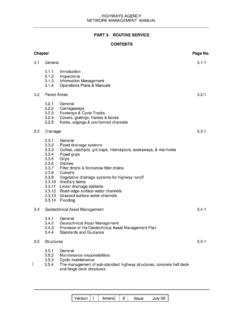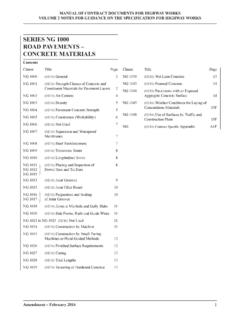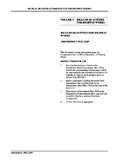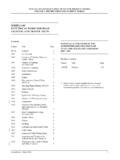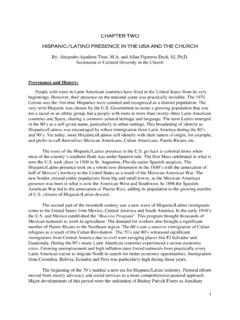Transcription of DMRB VOLUME 10 SECTION 5 PART 1 - Standards for Highways
1 February 2001 design MANUAL FOR ROADS AND BRIDGESVOLUME 10 ENVIRONMENTALDESIGN ANDMANAGEMENTSECTION 5 ENVIRONMENTALBARRIERSPART 1HA 65/94 design FOR ENVIRONMENTALBARRIERSSUMMARYThis Advice Note provides guidance for the design ofenvironmental barriers. It supersedes in part HA 14/76(DMRB ).INSTRUCTIONS FOR existing title page, content page andGeneral Preface page on the Goods Roads Guideseries of Advice new title this sheet as 65/94 design Guide forEnvironmental BarriersDESIGN MANUAL FOR ROADS AND BRIDGESTHE Highways AGENCYTHE SCOTTISH EXECUTIVE DEVELOPMENTDEPARTMENTTHE NATIONAL ASSEMBLY FOR WALESCYNULLIAD CENEDLAETHOL CYMRUTHE DEPARTMENT FOR REGIONAL DEVELOPMENT*Summary:This Advice Note provides guidance for the design of environmental barriers. Itsupersedes in part HA 14/76 (DMRB ).* A Government Department in Northern IrelandVolume 10 SECTION 5 part 1 HA 65/94 July 1994 REGISTRATION OF AMENDMENTSA mendPage NoSignature & Date ofAmendPage NoSignature & Date ofNoincorporation ofNoincorporation ofamendmentsamendmentsRegistration of AmendmentsVolume 10 SECTION 5 part 1 HA 65/94 July 1994 REGISTRATION OF AMENDMENTSA mendPage NoSignature & Date ofAmendPage NoSignature & Date ofNoincorporation ofNoincorporation ofamendmentsamendmentsRegistration of AmendmentsVOLUME 10 ENVIRONMENTALDESIGNSECTION 5 ENVIRONMENTALBARRIERSPART 1HA 65/94 design GUIDE FORENVIRONMENTAL of design Appearance of design for Rural design for Semi-Urban design for Urban and Operational Barrier design Assessment Case Case Case MANUAL FOR ROADS AND BRIDGESJuly 1994 design GUIDE FOR environmental BARRIERSJuly 1994 VOLUME 10 SECTION 5 part 1 HA 65/94 ContentsC/1 design GUIDE FOR ENVIRONMENT
2 BARRIERS1. INTRODUCTIONB ackground1/1 Scope1/1 Implementation1/1 design Philosophy1/22. OVERVIEW OF design CRITERIAC onsideration of Options2/1 Land Requirements2/3 Statutory Obligations2/4 Reduced Visual Intrusion2/5 Noise Reductions2/5 Approach to Barrier Design2/9 Architectural Input2/11 Barriers in the United Kingdom2/13 Continental Practice2/143. THE APPEARANCE OF BARRIERSV isual Impact3/1 Compatibility with Local Features3/2Co-ordination with Road Furniture3/4 Response to the Road Environment3/5 The Protected Side3/7 The Road Users Side3/8 Materials3/9 Use of Vegetation3/10 Modifications to Barrier Design3/11 Use of Colour3/124. BARRIER design FOR RURAL CONTEXTSD esign Considerations4/1 Earth Mounds4/2 Supported Earth Mounds4/3 Traditional Methods of Enclosure4/4 Earth Mounds with Barriers on Top4/6 Vegetated Barriers4/7 Road Safety4/85. BARRIER design FOR SEMI-URBAN CONTEXTSD esign Considerations5/1 Earth Retention and Planting5/4 Vegetated Forms of Barrier5/5 Traditional Hard Materials5/7 Absorbent Barriers5/7 Detailing on the Protected Side5/8 July 1994 VOLUME 10 SECTION 5 part 1 HA 65/95 ContentsC/26.
3 BARRIER design FOR URBAN CONTEXTSD esign Considerations6/1 The Impact of Tall Barriers6/3 Use of Transparent Barriers6/4 Protection of Tall buildings6/5 Secondary Glazing6/5 Absorbent Materials6/6 Other Considerations6/67. CONSTRUCTION AND OPERATIONAL FACTORST iming of Construction7/1 Barriers over Structures7/1 Sight Lines7/1 Light and Shade7/2 Access for Maintenance7/2 Escape Doors7/2 Pedestrian or Cycle Routes7/28. environmental BARRIER design PROCESSS tages in Development ofThe Preferred Solution8/1 Summary Chart8/49. BARRIER ASSESSMENT FRAMEWORKO verview9/1 Visual and Acoustic Factors9/3 Cost Considerations9/410. RURAL CASE STUDIESSite A - Moorland10/1 Site B - Arable plain10/7 Site C - Pastoral10/1311. SEMI-URBAN CASE STUDIESSite A - Railway crossing11/1 Site B - Road crossing11/612. URBAN CASE STUDIESB ackground12/1 Site A - Vicinity of Castle Trade Centre12/8 Site B - Highfields residential area12/16 Site C - St Peters Park locality12/24 Site D - Fairview conservation area12/30 Site E - St Peters Tower and environs12/3613.
4 ENQUIRIES13/1 July 1994 VOLUME 10 SECTION 5 part 1 HA 65/94 Chapter 11 1990 White Paper This Common Inheritance set down theGovernment policies for the environment. The White Paper noted the caretaken to select lines and levels for roads that minimise the impact of thenoise on local people, and highlights the role of earth mounds and noisebarriers as a means deflecting noise away from people. The White Paperalso recognised that these may incidentally improve the appearance ofthe environmental barrier combines the function of a visual screenand a noise barrier to protect residential, recreational and other vulnerableareas alongside a road. This document l gives advice on how the impactof the barrier itself on its surroundings can be minimised by the appropriatechoice of the form and materials used, at the same time taking advantageof developments in the techniques of noise procurement of environmental barriers will normally be carriedout under contracts incorporating the Overseeing Organisation sSpecification for Highway Works (MCHW 1).
5 Products conforming toequivalent Standards and specifications of, and tests undertaken in, otherstates of the European Economic Area will be acceptable in accordancewith the terms of clauses 104 and 105 of MCHW 1. For contracts notincorporating this form of specification, advice should be sought on suitableclauses of mutual recognition which would have the same document extends the advice given in HA 58/92 Chapter 8(DMRB ) and HA62/92 Chapter 7 (DMRB ). It supersedesparagraph of HA 14/76 (DMRB ); a companion document HA 66/904 is in preparation which will update the technical requirements forenvironmental barriers, superseding the remainder of HA 14 Advice Note should be used for all schemes currently inpreparation provided that, in the opinion of the Overseeing Organisation,this would not result in significant additional expense or delay organisations should confirm its application to particular schemeswith the Overseeing 1994 VOLUME 10 SECTION 5 part 1 HA 65/95 Chapter 11/2 IntroductionDesign new road can have a profound effect on the quality of life forresidents in its vicinity.
6 In addition to the noise, dust and fumes caused bytraffic, the road may restrict access to local facilities and obstruct viewsof the surroundings. Barriers can be incorporated into the scheme designto mitigate the immediate effects of traffic, but they may create anoppressive sense of enclosure unless they are sensitively designed. Theaim should be to make then as unobtrusive in the landscape as possible,or to provide interest and visual quality whenever integration is not approach will create opportunities for imaginative treatment of theprotected side of the barrier in guide does not prescribe a standard range of barriers fromwhich to make a selection, as this could lead to a restricted considerationfactors which might be important to fitting barriers to their context. Thedesign concepts for barriers may vary considerably in response to thedifferent impacts that a road can have in urban, semi-urban and ruralcontexts.
7 Instead a step by step approach is set out which should ensurethat the constraints and opportunities in each situation are first part of this guide discusses the variety of forms whichbarriers can take and the factors which need to be considered in differentsituations. The case studies in chapters 10, 11 and 12 work through thedesign method for a number of typical situations in different contexts. Morespecific details of acoustic performance and engineering requirementsfor the range of structural materials considered in the guide will be givenin HA 66/94 (DMRB ).July 1994 VOLUME 10 SECTION 5 part 1 HA 65/94 Chapter 22/1 Overview of design OF design CRITERIAC onsideration of design of a new road involves achieving a balance betweenmeeting the needs of traffic and minimising its intrusion on the localenvironment. Routes which pass close to residential property need to beassessed for the effects of traffic noise and visual traffic noise can be controlled in several ways:a)by distancing the road so far away that the noise received it minimal;b)by placing the road in cutting;c)by constructing a barrier (fence, wall or earth mound) whichimpedes the transmission of noise;d)by containment at source eg: by constructing the road in a tunnel,or by using noise reducing road surfaces;e)by insulation at reception point eg: by provision of 1994 VOLUME 10 SECTION 5 part 1 HA 65/95 Chapter 22/2 Overview of design of these methods has limitations:a)the alignment of the road is dictated by many factors which maymake it impossible to achieve noise attenuation by distance alone;b)engineering factors or vertical alignment may rule out cuttings incertain locations;c)barriers can deprive occupants of views previously enjoyed.
8 D)tunnels are often too expensive to be a realistic option, and noisereducing road surfaces are at present relatively expansive toconstruct the maintain;e)insulation does not screen occupants from adverse visual affectsor from noise when they are outside the 1994 VOLUME 10 SECTION 5 part 1 HA 65/94 Chapter 22/3 Overview of design environmental barrier will often provide the most appropriatemeans of mitigating noise over a wide area. A barrier may take the formof an acoustic fence, or an earth mound and may be used in combinationwith other measures, such as lowering the vertical alignment, falsecuttings , and secondary glazing of to mitigate the adverse effects of noise and visualintrusion should be considered at an early stage. Alignment options shouldinclude sufficient land to allow the most appropriate form of mitigation tobe used. As the character of the new road is often alien to its surroundings,it is desirable to create a buffer zone between the road and its is a prime requirement in achieving this objective.
9 If considerationof the need for an environmental barrier is delayed until after compulsorypurchase orders have been published, the options are likely to be limitedto unnecessarily intrusive and potentially more expensive soon as potential interaction is identified, noisespecialists, landscape architects and architects should be broughtinto the design team to advise on options for 1994 VOLUME 10 SECTION 5 part 1 HA 65/95 Chapter 22/4 Overview of design CriteriaStatutory the respective legislation, occupiers of property within 300mof a new road are entitled to be offered appropriate insulation if the noisefrom traffic on it reaches a specified level at the property. The entitlementto insulation is governed by the Noise Insulation Regulations which referto the method of noise prediction to be used. The respective legislationfor each of the Overseeing Organisations is shown in Table occupier of a property may also claim monetary compensationfor any loss in value of the property caused by the presence of the may be payable even where the noise at a property doesnot reach the qualifying level and whether or not it is situated within 300mof the road.
10 Careful consideration of road alignment options and mitigationmeasures can avoid noise and visual intrusion on properties, withconsequential savings in compensation authorities are empowered to carry out works formitigating any adverse effect which the construction, existence or use ofa highway has or will have on its surroundings . They are also given thepower to acquire land additional to that needed for construction of theroad itself to permit landscaping or the creation of earth mounds. Theinterpretation of works in this context is fairly broad and includes amenitytreatment such as grassing and planting of trees and shrubs on landscapeareas. In this context both noise and visual intrusion are adverse effectswhich can properly be mitigated by the use of earth mounds, barriers affected by new roads may in extreme cases beacquired at the discretion of the highway authority where mitigation cannotprevent living conditions becoming intolerable either during constructionor after the road is opened.

